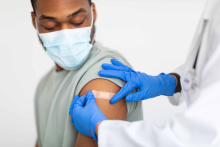
Meningococcal disease is caused by the bacterium Neisseria meningitidis and can have serious, life-threatening outcomes. Two types of vaccines are recommended for adolescents and young adults in the United States (US) to protect against meningococcal serotypes ACWY (MenACWY) and B (MenB).
Vaccination against MenACWY is recommended routinely at 11-12 years of age followed by a booster dose at 16 years, while vaccination against MenB is recommended for adolescents and young adults 16-23 years of age based on shared clinical decision making. Several published studies have demonstrated less than optimal rates of vaccination (uptake) of these vaccines in the US, especially in the older age group and for MenB.
Health Disparities
To determine the impact of health disparities and suboptimal meningococcal immunization, researchers conducted a systematic literature review (SLR) to identify studies that examined the relationship between health disparities and awareness and uptake of meningococcal vaccines in the US.
Suboptimal Vaccination Coverage
This SLR, coauthored by RTI Health Solutions researchers, revealed differences in vaccination coverage (uptake) over time, based on racial/ethnic background, geographic regions, socioeconomic status, insurance status, and access to physicians. However, the differences were not consistent across studies and varied according to the analytic methods used. Results showed that – despite current recommendations for meningococcal vaccination – adolescents and young adults are at risk for under-immunization, especially those with health inequities that are experienced by disadvantaged populations or marginalized communities. Other factors associated with a suboptimal uptake of meningococcal vaccines were a lack of awareness among the target population, accessibility to vaccine providers, and insurance coverage issues. Moreover, this study uncovered variability and confusion around recommendations for shared decision making between patient and provider and barriers related to the understanding of financial reimbursement among healthcare professionals.
One study limitation was the lack of studies containing specific marginalized communities such as indigenous groups. Additionally, in some included studies, there were analytic challenges. For example, some of the impact of race on MenACWY vaccine uptake was likely captured by the association of race with poverty, geographic area, and access to primary care.
In order to reduce the number of severe infections, additional research is needed to understand how health inequity is affecting the awareness and uptake of meningococcal vaccinations.
The impact of social determinants of health on meningococcal vaccination awareness, delivery, and coverage in adolescents and young adults in the United States: a systematic review. Masaquel C, Schley K, Wright K, Mauskopf J, Parrish RA, Presa JV, Hewlett, Jr. D. Vaccines-Basel. 2023 Jan 24;11(2):256. doi: 10.3390/vaccines11020256
